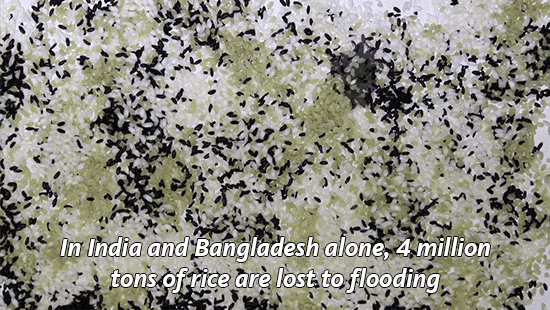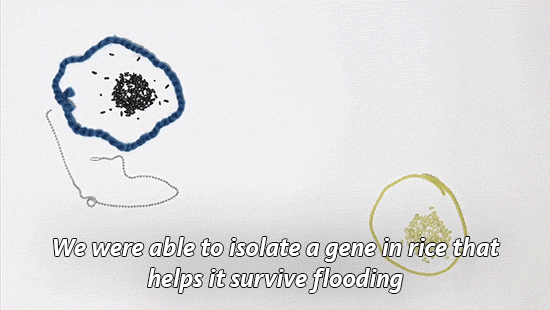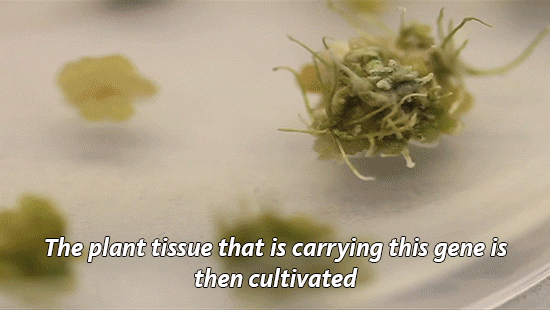103 posts
Latest Posts by redplanet44 - Page 4
The end of heartless b*tches

This realistic 3D-printed silicon heart could help people in need of heart transplants when there are not enough donors.
GMO does NOT mean Generally Mean Organizations.




Why we need GMOs to survive climate change
Genetically modified organisms get a bad rap for many reasons, but we’ve actually been genetically altering what we eat since the dawn of human history.
“For 10,000 years, we have altered the genetic makeup of our crops,”explains UC Davis plant pathology professor Pamela Ronald.
“Today virtually everything we eat is produced from seeds that we have genetically altered in one way or another.” (You can read more about Ronald’s thoughts on genetically engineered food here.)
Right now her focus is on rice. It’s one of our basic crops and without it, we would struggle to feed much of the world.
With climate change, we’re seeing an increase in flooding in places like India and Bangladesh, which makes it harder to grow this important food staple.
So Ronald and her lab have developed a flood-tolerant strain of rice. It’s known as Sub1a or “scuba rice” and millions of farmers in South Asia are now growing it in their fields.

Today is National Food Day, a day dedicated to hunger awareness. But as we focus on food insecurity, we need to talk more about how global warming will make the problem worse.
As our climate continues to heat up, it has huge impacts on what foods we are able to grow. Will our crops be able to survive droughts and floods? The University of California leads six labs that are working to develop other climate-resilient crops including chickpea, cowpea and millet.
Find out what other scientists are doing to improve our food.
It seems nuCLEARer now









The Sun’s Energy Doesn’t Come From Fusing Hydrogen Into Helium (Mostly)
“It might surprise you to learn that hydrogen-fusing-into-helium makes up less than half of all nuclear reactions in our Sun, and that it’s also responsible for less than half of the energy that the Sun eventually outputs. There are strange, unearthly phenomena along the way: the diproton that usually just decays back to the original protons that made it, positrons spontaneously emitted from unstable nuclei, and in a small (but important) percentage of these reactions, a rare mass-8 nucleus, something you’ll never find naturally occurring here on Earth. But that’s the nuclear physics of where the Sun gets its energy from, and it’s so much richer than the simple fusion of hydrogen into helium!”
Ask anyone where the Sun (or any star) gets its energy from, and most people will correctly answer “nuclear fusion.” But if you ask what’s getting fused, most people – including most scientists – will tell you that the Sun fuses hydrogen into helium, and that’s what powers it. It’s true that the Sun uses hydrogen as its initial fuel, and that helium-4 is indeed the end product, but the individual reactions that take place to turn hydrogen into helium are surprisingly diverse and intricate. There are actually four major reactions that take place in the sun: fusing two protons into deuterium, fusing deuterium and a proton into helium-3, fusing two helium-3 nuclei into helium-4, and fusing helium-3 and helium-4 in a chain reaction to produce two helium-4 nuclei. Note that only one of those reactions actually turns hydrogen into helium, and that’s not what makes up either the majority of reactions or the majority of the Sun’s energy!
The Sun fuses hydrogen into helium, but that’s not the only thing that powers it. Come find out how the Sun really works today!
Vacuuma Matata

SOS Save our sounds
Tyson fights like Tyson with words





8.28.17
) ... i mean ;)

Hmm
Vacuum printer. Fill up the empty space.

One manufacturing company just made history by successfully using a special 3D printer in extreme, space-like conditions.
The team printed polymer alloy parts in a super-high vacuum, and hope their new tech will allow the design and manufacture of much more ambitious spacecraft and space-based telescopes.
“This is an important milestone, because it means that we can now adaptively and on demand manufacture things in space,” Andrew Rush, CEO of Made in Space, told Scientific American.
Continue Reading.
Food for thought
We might won`t need a last supper yet
I need some C - H - O - CO late

My friend just sent me this so y'all have to suffer too
Biggest Ferris wheel ever: the Jupiter Eye





NASA just released Juno’s brand-new images of Jupiter’s red spot — and they’re jaw-dropping
follow @the-future-now
Eric Magnus Lensherr-sphere
Magnetospheres: How Do They Work?
The sun, Earth, and many other planets are surrounded by giant magnetic bubbles.

Space may seem empty, but it’s actually a dynamic place, dominated by invisible forces, including those created by magnetic fields. Magnetospheres – the areas around planets and stars dominated by their magnetic fields – are found throughout our solar system. They deflect high-energy, charged particles called cosmic rays that are mostly spewed out by the sun, but can also come from interstellar space. Along with atmospheres, they help protect the planets’ surfaces from this harmful radiation.
It’s possible that Earth’s protective magnetosphere was essential for the development of conditions friendly to life, so finding magnetospheres around other planets is a big step toward determining if they could support life.
But not all magnetospheres are created equal – even in our own backyard, not all planets in our solar system have a magnetic field, and the ones we have observed are all surprisingly different.

Earth’s magnetosphere is created by the constantly moving molten metal inside Earth. This invisible “force field” around our planet has an ice cream cone-like shape, with a rounded front and a long, trailing tail that faces away from the sun. The magnetosphere is shaped that way because of the constant pressure from the solar wind and magnetic fields on the sun-facing side.

Earth’s magnetosphere deflects most charged particles away from our planet – but some do become trapped in the magnetic field and create auroras when they rain down into the atmosphere.

We have several missions that study Earth’s magnetosphere – including the Magnetospheric Multiscale mission, Van Allen Probes, and Time History of Events and Macroscale Interactions during Substorms (also known as THEMIS) – along with a host of other satellites that study other aspects of the sun-Earth connection.


Mercury, with a substantial iron-rich core, has a magnetic field that is only about 1% as strong as Earth’s. It is thought that the planet’s magnetosphere is stifled by the intense solar wind, limiting its strength, although even without this effect, it still would not be as strong as Earth’s. The MESSENGER satellite orbited Mercury from 2011 to 2015, helping us understand our tiny terrestrial neighbor.


After the sun, Jupiter has by far the biggest magnetosphere in our solar system – it stretches about 12 million miles from east to west, almost 15 times the width of the sun. (Earth’s, on the other hand, could easily fit inside the sun.) Jupiter does not have a molten metal core like Earth; instead, its magnetic field is created by a core of compressed liquid metallic hydrogen.

One of Jupiter’s moons, Io, has intense volcanic activity that spews particles into Jupiter’s magnetosphere. These particles create intense radiation belts and the large auroras around Jupiter’s poles.

Ganymede, Jupiter’s largest moon, also has its own magnetic field and magnetosphere – making it the only moon with one. Its weak field, nestled in Jupiter’s enormous shell, scarcely ruffles the planet’s magnetic field.
Our Juno mission orbits inside the Jovian magnetosphere sending back observations so we can better understand this region. Previous observations have been received from Pioneers 10 and 11, Voyagers 1 and 2, Ulysses, Galileo and Cassini in their flybys and orbits around Jupiter.

Saturn’s moon Enceladus transforms the shape of its magnetosphere. Active geysers on the moon’s south pole eject oxygen and water molecules into the space around the planet. These particles, much like Io’s volcanic emissions at Jupiter, generate the auroras around the planet’s poles. Our Cassini mission studies Saturn’s magnetic field and auroras, as well as its moon Enceladus.


Uranus’ magnetosphere wasn’t discovered until 1986 when data from Voyager 2’s flyby revealed weak, variable radio emissions. Uranus’ magnetic field and rotation axis are out of alignment by 59 degrees, unlike Earth’s, whose magnetic field and rotation axis differ by only 11 degrees. On top of that, the magnetic field axis does not go through the center of the planet, so the strength of the magnetic field varies dramatically across the surface. This misalignment also means that Uranus’ magnetotail – the part of the magnetosphere that trails away from the sun – is twisted into a long corkscrew.


Neptune’s magnetosphere is also tilted from its rotation axis, but only by 47. Just like on Uranus, Neptune’s magnetic field strength varies across the planet. This also means that auroras can be seen away from the planet’s poles – not just at high latitudes, like on Earth, Jupiter and Saturn.

Does Every Planet Have a Magnetosphere?
Neither Venus nor Mars have global magnetic fields, although the interaction of the solar wind with their atmospheres does produce what scientists call an “induced magnetosphere.” Around these planets, the atmosphere deflects the solar wind particles, causing the solar wind’s magnetic field to wrap around the planet in a shape similar to Earth’s magnetosphere.

What About Beyond Our Solar System?
Outside of our solar system, auroras, which indicate the presence of a magnetosphere, have been spotted on brown dwarfs – objects that are bigger than planets but smaller than stars.
There’s also evidence to suggest that some giant exoplanets have magnetospheres. As scientists now believe that Earth’s protective magnetosphere was essential for the development of conditions friendly to life, finding magnetospheres around exoplanets is a big step in finding habitable worlds.
Make sure to follow us on Tumblr for your regular dose of space: http://nasa.tumblr.com
Science gets one horsepower fast

It was one of the very first motion pictures ever made: a galloping mare filmed in 1878 by the British photographer Eadweard Muybridge, who was trying to learn whether horses in motion ever become truly airborne.
More than a century later, that clip has rejoined the cutting edge. It is now the first movie ever to be encoded in the DNA of a living cell, where it can be retrieved at will and multiplied indefinitely as the host divides and grows.
The advance, reported on Wednesday in the journal Nature by researchers at Harvard Medical School, is the latest and perhaps most astonishing example of the genome’s potential as a vast storage device.
Continue Reading.

A new study has revealed that compounds present in the Martian soil can wipe out whole bacterial cultures within minutes.
Researchers have had their suspicions over whether microorganisms can actually survive on the surface of the Red Planet, and now lab tests are spelling doom for any potential little green bacteria. And yeah, growing potatoes on Mars might be more difficult than we thought.
The problem here lies with perchlorates - chlorine-containing chemical compounds that we first detected on Mars back in 2008. These salty compounds are also what makes water on the Martian surface stay liquid, essentially turning it into brine.
Perchlorates are considered toxic for people, but they don’t necessarily pose a problem for microbes. And because they keep surface water liquid, on Mars the presence of these compounds could even be beneficial for life - or so we thought.
Researchers from the University of Edinburgh have now confirmed that when you pair the compounds with intense ultraviolet (UV) light exposure, things become grim for any life forms.
Continue Reading.